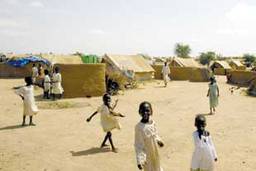Oncoming Catastrophe
The United Nations’ continued inaction could lead to 1 million deaths in Sudan
Eric Reeves

The genocide in the Darfur region of western Sudan is accelerating in ways that are all too predictable. For months, the National Islamic Front regime in Khartoum has waged war, directly and through proxy Arab militias, on the African civilian populations in this region the size of France. (See “Genocide in Sudan,” May 31.)
This deliberate, systematic assault on the African tribal groups — primarily the Fur, Massaleit and Zaghawa — is now universally described as the world’s greatest humanitarian crisis. The impending famine, a result of massive violence and the resulting displacement of people, will claim hundreds of thousands of lives.
Andrew Natsios, administrator for the U.S. Agency for International Development (USAID), has given the grimmest and most persuasive forecast: “We estimate right now if we get relief in, we’ll lose a third of a million people. And if we don’t, the death rates could be dramatically higher, approaching a million people.” Others have echoed this assessment, including an Amnesty International researcher just back from the Chad/Darfur border: “There are 350,000 people who are most likely to die in this period [the rainy season from June to September].”
Data from USAID and humanitarian malnutrition assessments suggest that in addition to the more than 50,000 who already have died, more than 600 people are dying daily from disease and starvation. The daily mortality rate is likely to rise to more than 3,000 per day during the rainy season, which shuts down the roads and the humanitarian corridors between Chad and Darfur.
The United Nations and others have underestimated the extent of the catastrophe in part for political reasons and in part because of ineptitude. Consider U.N. estimates of the number of “war-affected” — people either displaced or dependent upon humanitarian assistance. That number grew from 1.1 million in April to 2 million in May. This increase of 900,000 “war affected” in one month overwhelmed previous humanitarian planning. For months the estimated figure for refugees who had fled to Chad remained fixed at 110,000, even in light of continual reports that thousands of fleeing civilians crossed the border weekly. The United Nations now accepts the figure of 200,000 compiled by Refugees International.
Certainly, assessments have been made extremely difficult by the Khartoum regime, which continues to impede humanitarian access, with deadly consequences. By refusing to rein in its Arab militia allies (the Janjaweed), Khartoum has ensured that insecurity prevails throughout Darfur. News and human rights reporters have begun to gain some access to Darfur, but gathering information is difficult and often dangerous. Most data still comes from refugees in Chad.
Even in Chad conditions are terrible. Jean-Charles Dei of the U.N. World Food program recently warned: “I don’t think any of the children under the age of 5 will make it, and the pregnant women, too. For those who are under 5 there is no chance. They will die from starvation.”
In Darfur itself, the African tribal groups that have fled their homes have ended up in concentration camps that have become extermination sites. An inter-agency U.N. team found in one of these camps conditions of “imprisonment” and a “systematic policy of starvation.” With the rains, water-borne diseases such as cholera are poised to claim many thousands of lives in these camps. Malnourished children are particularly vulnerable, allowing normally nonfatal diseases like measles to become remorseless killers.
The international community has failed to respond to Darfur’s catastrophe with anything approaching appropriate urgency. Part of the blame lies with the United States and Britain, which have muted criticism of Khartoum’s genocidal campaign in Darfur in the illusory hopes that silence would expedite a north-south peace deal and end Sudan’s other civil war. (A preliminary peace accord was finally signed on May 26, 2004, months after initial U.S. “deadlines.”)
The only recourse now is humanitarian military intervention. Human Rights Watch has called for such intervention under Chapter VII authority of the U.N. Charter. The International Crisis Group in Brussels has similarly called on the United Nations to act. But the U.N. Security Council gives no sign of having heard. China is almost certain to veto any such resolution. (China’s huge oil interests in southern Sudan define Beijing’s interest in the country.)
Consequently, the only alternative is non-U.N. multilateral humanitarian intervention. Such an intervention must have three goals: to free the people held in concentrations camps; to protect the threatened African populations; and to internationalize the rail line running from Port Sudan on the Red Sea westward through Khartoum to Darfur, which could provide adequate humanitarian transport capacity. That such intervention is an extreme improbability must be reckoned as another cost of the Iraq war.
In all likelihood, we will be obliged to watch from afar as another African genocide, this time in slow-motion, unfolds over the coming months. Sadly, the unctuous pieties of the last two months, commemorating the grim 10th anniversary of Rwanda, have proved meaningless.







